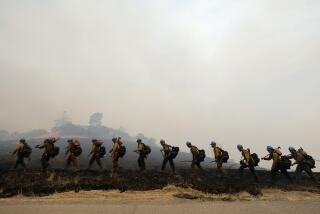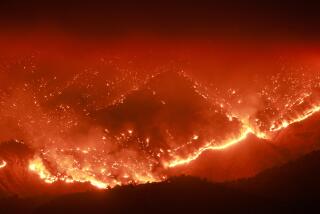Yosemite in spotlight but towns nearby suffer losses
- Share via
MARIPOSA, CALIF — . -- Residents to the world: What about us?
As the Telegraph fire raged through the wilderness for the fifth day Tuesday, amused locals wondered why Yosemite National Park was getting all the ink.
Sure, the park’s famous vistas are obscured by smoke. And many hotel rooms there remained without power, but “it’s Mariposa’s fire,” said Darci Bazinet, 35, who evacuated with her three children and four pets Saturday. “It’s burning our houses. It’s not in the national park.”
The fire continued to burn Tuesday about 10 miles west of the park entrance on California Highway 140 and 20 miles from Yosemite Valley proper, with its breathtaking waterfalls and world-renowned granite walls.
Although headlines like the one on WNBC’s website screamed “Yosemite Fire Burns Almost Out of Control,” the 21 houses destroyed in the nearly 30,000-acre conflagration are in craggy canyons near the small towns of Mariposa and Midpines.
Capt. Cheryl Goetz of the California Department of Forestry and Fire Protection said the big threats now are to Greeley Hill to the north and to El Portal, company town for the park’s administrative offices and employees.
As nearly 3,500 firefighters battled the blaze -- only 15% contained and still threatening 4,000 structures -- Pacific Gas and Electric workers struggled for a second day to restore power to more than 1,000 customers.
On Monday, the utility trucked two generators to the area in an effort to bring power to 561 businesses and homes -- including those in Yosemite Valley -- that were affected when a major transmission line was damaged by the fire.
PG&E; officials had hoped to have the generator running Monday night. But because of equipment problems, it was still not operating Tuesday afternoon, company spokeswoman Tamar Sarkissian said.
An additional 600 customers lost power when the company “de-energized” various distribution lines as a safety precaution for firefighters.
Fire officials on Tuesday cleared PG&E; crews to begin checking out those lines, Sarkissian said, and power could be restored to those customers as early as today.
Clearing smoke allowed firefighters to take their battle to the air, and helicopters and planes spent the day dropping water and fire retardant, Telegraph fire spokeswoman Sarah Gibson said. As a result, Highway 140 remained closed east of Midpines.
Bill Sigafoos enjoyed a precarious front-row seat for the aerial spectacle.
Skeptical of what he was hearing on the TV news, Sigafoos hiked in over the weekend to his backwoods dream house on eight acres, miles outside Mariposa.
“I wanted to see for myself,” he said.
A 61-year-old Vietnam veteran retired from working life in Orange County, Sigafoos watched helicopters divebomb the blaze with water each afternoon as it reared up to attack his rural neighborhood.
“I saw a lot in Vietnam, but this aerial assault was second to none,” he said.
“They dug in their heels and decided our homes, our little piece of the woods, wasn’t going to burn,” he said.
Figuring that the war was over after three days, Sigafoos hiked back out Tuesday to find his wife, Cheryle, “going ballistic” after three nights alone in an emergency shelter.
But as they checked into a Mariposa hotel for a shower and soft bed, the wind picked up.
Smoke began to billow. The firefighting helicopter fleet headed back into the battle.
“I thought everything was great. Now it doesn’t look so good,” he said. “All I can do is wait.”
-
maria.laganga@latimes.com
More to Read
Sign up for Essential California
The most important California stories and recommendations in your inbox every morning.
You may occasionally receive promotional content from the Los Angeles Times.











